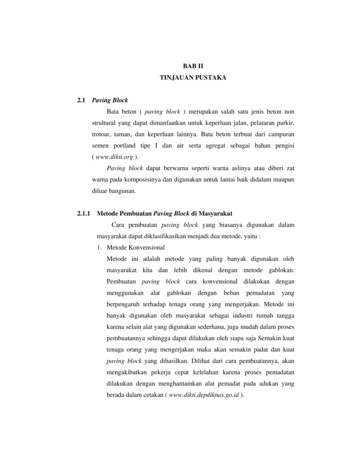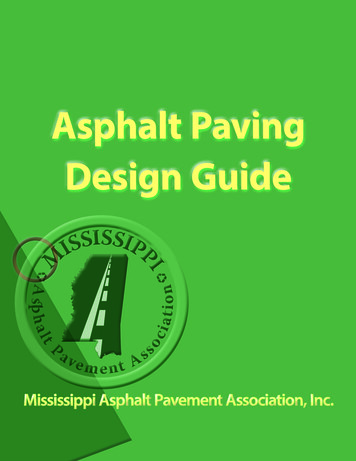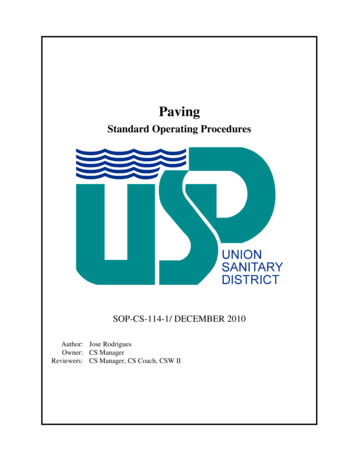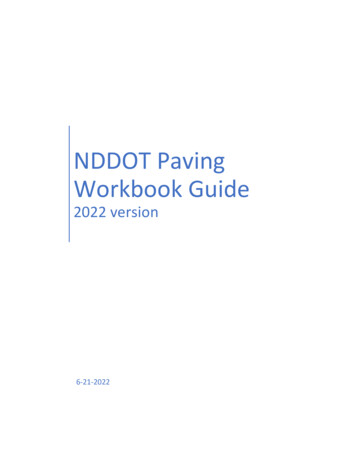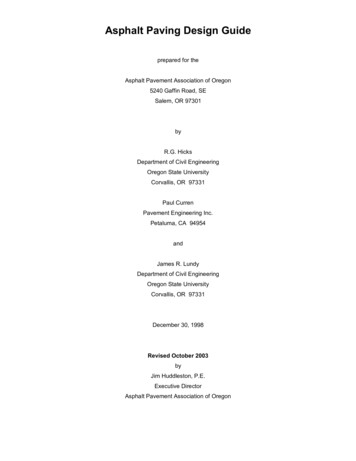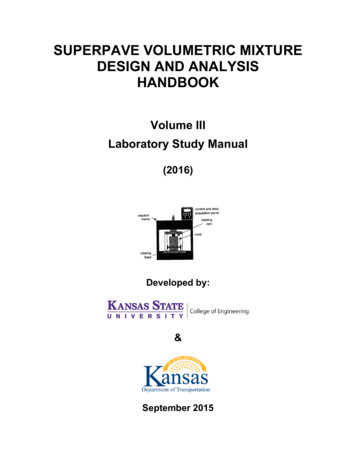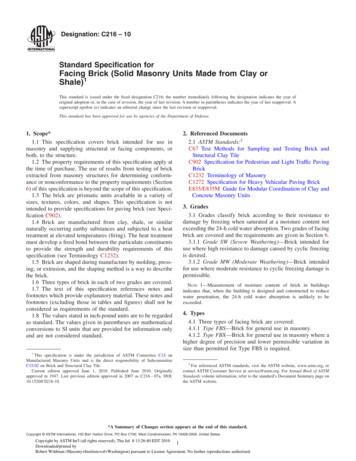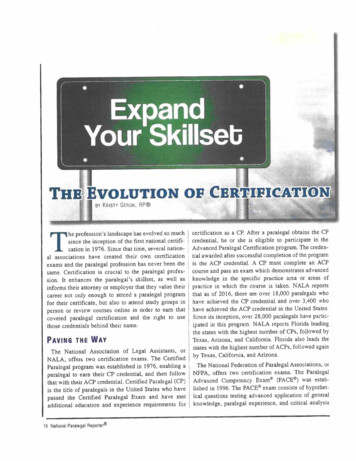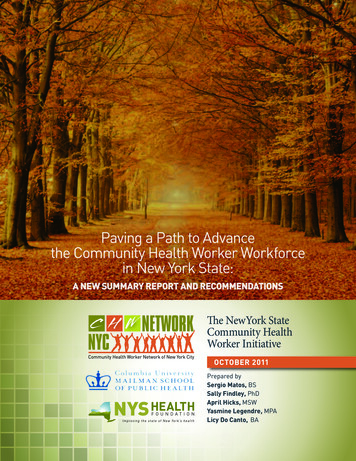
Transcription
January–March 2012Inside this issue2 From the director:Opportunities and options4 Dealing with frost boils andheaves5 Pavement marking options forIowa’s low-volume rural roads7 Conference calendar7 Iowa LTAP welcomesKaren Koppenhaver7 Making Every Day Count (EDC)7 Online registrationDe-paving: A potential optionfor some of Iowa’s low-volume roadsWith escalating costs and bare-bones budgets, Iowa’s local road agencies are lookingfor alternative solutions for maintaining orreconstructing worn-out paved roadways.Although the problem is most acute in ruralareas, some small municipalities are alsoaffected.One option is to revert failing low-volumepaved roadways to aggregate/gravel-surfacedroadways (gravel roads). This article provides an overview of this potential solution.The need for low-cost alternativesFor several decades beginning in the 1960s,thousands of miles of Iowa’s rural gravelroadways—especially farm-to-marketroads—were paved. This paving spree waspart of a national trend, reflecting the needsof the farm economy, high demand from therural population, and relatively flush localroads budgets.Since many of these roads were paved, theirtraffic volumes and types have changed.Mega-sized agricultural equipment is nowcommon, as is heavy truck traffic for ruralagribusiness and commercial development.Rural subdivisions create pockets of highaverage daily traffic (ADT) on commuterroads. As a result, many rural pavements areexperiencing very different traffic than theywere designed for.Today, many of these pavements are reaching the end of their life spans—some ofthem literally crumbling apart. For somepaved rural roads, damage related toextremely wet springs in recent years hasbeen the final death rattle.Meanwhile, the cost of maintaining, rehabilitating, and replacing paved roadwayshas soared. For example, the cost of asphaltcement—a petroleum-based material—hasmore than doubled in the last 10 years.During the same period or longer, local roadagency revenue shortfalls have become thenorm, especially during the recent nationaleconomic downturn.Without significant funding increases, it willbe impossible to continue maintaining and/DE-PAVING continued on page 3Iowa Local Technical AssistanceProgram2711 S. Loop Drive, Suite 4700Ames, IA 50010-8664Phone: 515-294-8103FAX: 515-294-0467www.intrans.iastate.edu/ltapTruck loadings on rural roads have significantly increased since many of the roads were first paved(photo courtesy of SD LTAP)
2 Technology News January–March 2012Acronyms and Abbreviations inTechnology NewsAASHTO American Association of State Highway and Transportation OfficialsAPWAAmerican Public Works AssociationFHWAFederal Highway AdministrationIHRBIowa Highway Research BoardInTransInstitute for Transportation (at ISU)From the director:Opportunities and optionsof interest. We need to determine, however,which training opportunities are relevant anduseful to local agencies and the most effectivemanner to share that information.Iowa DOT Iowa Department of TransportationISUIowa State UniversityLTAPLocal Technical Assistance ProgramMUTCDManual on Uniform Traffic ControlDevicesNACENational Association of CountyEngineersTRBTransportation Research BoardAbout LTAPLTAP is a national program of the FHWA. Iowa LTAP,which produces Technology News, is financed by theFHWA and the Iowa DOT and administered by theInstitute for Transportation at Iowa State University:Institute for TransportationISU Research Park2711 S. Loop Drive, Suite 4700Ames, Iowa 50010-8664Telephone: 515-294-8103Fax: 515-294-0467www.intrans.iastate.edu/DisclaimersAny reference to a commercial organization or productin this newsletter is intended for informationalpurposes only and not as an endorsement.The opinions, findings, or recommendationsexpressed herein do not necessarily reflect the viewsof LTAP sponsors. All materials herein are providedfor general information, and neither LTAP nor itssponsors represent that these materials are adequatefor the purposes of the user without appropriateexpert advice.Iowa State University makes no representations orwarranties, expressed or implied, as to the accuracy ofany information herein and disclaims liability for anyinaccuracies.NondiscriminationIowa State University does not discriminate onthe basis of race, color, age, religion, nationalorigin, sexual orientation, gender identity, geneticinformation, sex, marital status, disability, or statusas a U.S. veteran. Inquiries can be directed to ISU’sDirector of Equal Opportunity and Compliance,3810 Beardshear Hall, 515-294-7612.Subscribe to Technology NewsSubscriptions to Technology News are free. Subscribeonline (www.intrans.iastate.edu/pubs/Newsletter Request/mailform.cfm) or by contacting the editor (seepage 4).To obtain permission to reprint articles, contact theeditor (see page 4). Readers’ comments and articletopic suggestions are welcome.Printed with soy inkThe amount of training, particularly online,seems to be expanding exponentially. I think Iget information about something almost everyday. Some workshops—like the soon-to-bereleased online Gravel Road Maintenance andDesign training being developed by MinnesotaLTAP and the Minnesota DOT’s Local RoadResearch Board—will need to be reviewed andshared.In 2012 Iowa LTAP will continue to lookfor training opportunities and exploreoptions. The need for technical trainingfor local agencies continues to increase,and we are working to serve that demandas best we can. As I’ve indicated in severalof my columns, Iowa LTAP is always looking for new ideas and/or resources thatallow use to serve you better.New websiteWe will be updating our website this year.It will have a new look, and we hope itwill expand it into a more useful resourceof information about locally relevantextension/outreach efforts in Iowa andlocally applicable research results. Thewebsite will be a work in progress thisyear.Connecting you with training youneedIowa LTAP isn’t able to offer training inevery subject that is needed every year,but we keep your suggestions in mind.We also keep an eye out for other peopleand organizations that may offer trainingon those subjects within Iowa. The routesurveying course we co-sponsor withDMACC is one example of this approach.Our new online registration system,which some of you may have alreadyexperienced, will allow us to include inour calendar other organizations’ training workshops and webinars that may beStrategic planningWe are also thinking further down the road.In April we will be holding the first IowaLTAP strategic planning meeting. The objective is to gather information that will be usedto guide decision-making at Iowa LTAP forlong-term success.Highlights of recent and upcomingeventsIn February we hosted the Federal HighwayAdministration’s Every Day Counts (EDC)Exchange initiative (www.fhwa.dot.gov/everydaycounts/) webinar on geosyntheticreinforced soil (GRS) at three locations inIowa. Iowa’s Brian Keierleber from BuchananCounty was one of the speakers for thisnationally-broadcast webinar. The webinarwas recorded and will be posted online. Thenext EDC-Exchange webinar is on April 19,and the topic is flexibility in the ROW.Registration for several workshops in 2012 iscurrently open and more are being planned.Registrations are being accepted for 10-hourOSHA training from ARTBA, bridge inspection classes, and motor grader operatortraining. Other subjects being considered forlater this year include accessibility, concretepavements, asset management, and excavationsafety.Have a good 2012.Keith
January–March 2012 Technology News3DE-PAVING continued from page 1or reconstructing all of Iowa’s deterioratedpaved roads. One option is simply to reduceor eliminate maintenance of low-volumepaved roads.Local road agencies in several states (California, Indiana, Maine, Michigan, NorthDakota, Ohio, South Dakota, and Vermont)have been experimenting with anotheroption: “de-paving” very low-volume roadways, reverting them to gravel roads.impossible to maintain even marginal quality gravel surfaces.These findings are similar to those of a 2005InTrans study for the University of Minnesota’s Center for Transportation Studies. TheIowa researchers found that gravel surfacingis cost effective when daily traffic averagesless than 200 vehicles.Keys to successFor several years ending in 2010, KenSkorseth, field services manager for theSouth Dakota LTAP at South Dakota StateUniversity, working with the SD DOT, collected data from 26 counties (120 roadwaysections) and analyzed 20-year life-cyclecosts for three road surface types:In recent years, several counties in SouthDakota have successfully experimentedwith reverting low-volume roadways fromasphalt to gravel surfacing. Based on theirexperiences and his earlier research, Skorseth has become the national go-to personfor information and advice about de-pavingprojects and has developed several basic tipsto help ensure success: Gravel.Effective public communication Blotter (asphalt surface treatments such asprime/chip seal on aggregate base).Reverting a paved roadway to a gravel onecan involve a political battle. It is commonfor the affected residents to resist thischange. Good communication is your bestoption for gaining public support:Is de-paving cost effective? Hot-mixed asphalt pavements.The results of the study were fairly straightforward: In general, gravel surfacing iscost effective for roadways experiencingup to 170 ADT (150 ADT if user costs areconsidered).According to the South Dakota study, gravelroads with traffic volumes higher than 170ADT have extensive aggregate loss, requirefrequent blade maintenance, and will haveextensive loss of fine material due to roaddust, which can also be an environmental as well as a safety problem. All of thisresults in high life-cycle costs and reducedperformance. Above 300 ADT, it is almost Prepare simple documentation that clearlypresents the following information:In recent years,several countiesin South Dakotahave successfullyexperimented withreverting lowvolume roadwaysfrom asphalt togravel surfacing. Communicate with affected residents,personally whenever possible but also viabrief, informative mailings. Communicate with the general public viapublic meetings, your website, and newsmedia.– Total road funds available and thecurrent or projected shortfall tomaintain the road network.In spite of initial negative reactions, mostjurisdictions have experienced public acceptance after a smooth gravel road has beenconstructed.– Cost comparisons of paved andunpaved alternatives.Data-based roadway selection– Planned construction, summermaintenance, and winter maintenanceactivities.– Success stories from other jurisdictions.Skorseth suggests that failing paved roadways may be good candidates for revertingto gravel under the following conditions: Very low traffic volume (he suggestsapproximately 100 ADT). Low percentage of truck traffic. Nearby source of aggregate/gravel/recycled aggregate.(L) A badly deteriorated low-volume paved roadway in SD that might be a candidate for de-paving(R) Deuel Co. (SD) road turned back to gravel in mid-1980s; photo taken August 2010(photos courtesy of SD LTAP)David Creamer, a field operations specialistat the Center for Dirt and Gravel Road Studies at Pennsylvania State University, suggeststhat some hard-surfaced roadways may becandidates for surface recycling. Accordingto Creamer, new technology allows asphaltto be recycled into a durable gravel-likesurface that is cheaper to maintain andadequately prevents potholes and mud.DE-PAVING continued on page 6
4 Technology News January–March 2012Iowa LTAP MissionTo foster a safe, efficient, and environmentallysound transportation system by improving skills andknowledge of local transportation providers throughtraining, technical assistance, and technology transfer,thus improving the quality of life for Iowans.StaffShashi NambisanDirector of InTransshashi@iastate.eduKeith KnappDirector of Iowa LTAPkknapp@iastate.eduTom McDonaldSafety Circuit Ridertmcdonal@iastate.eduBob SperryLocal Roads Safety Liaisonrsperry@iastate.eduSabrina Shields-CookCommunications Managershieldsc@iastate.eduMarcia BrinkIssue Editormbrink@iastate.eduKaren KoppenhaverLTAP Program Coordinatorkkoppenh@iastate.eduAdvisory BoardThe professionals listed below help guide the policiesand activities of Iowa LTAP. Contact any of themembers to comment, make suggestions, or askquestions about any aspect of LTAP.Donna BuchwaldIowa DOT, Office of Local Systems515-239-1051donna.buchwald@dot.iowa.govGary FoxTraffic Engineer, City of Des Moines515-283-4973glfox@dmgov.orgTim HerrstromRoad Maintenance Foreman515-795-2825bctjh@iowatelecom.netBret HodneDirector of Public Works, City of West Des Moines515-222-3480bret.hodne@wdm-ia.comJoe JurasicTransportation Engineer, FHWA–Iowa515-233-7321joe.jurasic@fhwa.dot.govRon KnocheCity Engineer, City of Iowa City319-356-5138ron-knoche@iowa-city.orgCharlie PurcellIowa DOT, Office of Local er SchletzbaumMarion County id ShanahanCherokee County isty Van BuskirkKeokuk County Robert KiefferBoone County wa.govWade WeissGreene County Engineer515-386-5650wweiss@co.greene.ia.usDealing with frost boils and heavesThe unseasonably mild winter of2011–2012 may mean that Iowa’s roadmaintenance crews will have a belowaverage “crop” of spring frost boils and frostheaves to deal with. But some roadwayupheavals are inevitable, especially incounties that have received more snow and/or experienced colder temperatures. Suchdamage can occur in paved roadways, butthe following overview focuses on gravelor aggregate-surfaced roads.What causes frost boils and heaves?Although they are not the same, the termsfrost boils and frost heaves are often usedinterchangeably. Both forms of damageinvolve the breaking up of a section ofroadway surface where moisture fromspring thaws and/or precipitation cannotdrain adequately. The damage from bothfrost boils and frost heaves is often largeand deep enough to make a roadwayimpassable. The potential for damage isincreased after a severe winter, which deepens the frost layer, and/or where significantlate-winter or early-spring precipitationfurther saturates the soil.As temperatures begin to rise in the spring,frozen moisture in roadway surfaces andsupporting layers starts thawing from thetop down. Depending on the amountof frozen moisture in the ground, melting winter snow, and spring rain, and theextent to which drainage is inhibited, theresult is a saturated, muddy roadway surface, which is a problem in itself.The bigger problems occur in the support layers, as far down as the frost line.During the cold winter months, moisture inthese layers freezes and expands. As springtemperatures warm the support layers, themelting frost may produce a fluid subgradecondition that provides little or no support. Under traffic, the pressure is relievedthrough the point of least resistance—upthrough the roadway surface—producing amound of mud, or boil. The boil is a visualindication that the roadway is not stable.During the spring, the ground is subjectedto repeated freeze-thaw cycles. Whendrainage is inadequate and soils are frost-susceptible, ice lenses form that destabilizeand heave the soil, causing an upheavalof the roadway surface. Frost heaves aremost prevalent where there are silt and claysubgrades.How can damage be repaired?The only sure cure for frost boils and heavesis a sustained period of wind, sun, and dryweather to dry the roadway and allow forthorough road repairs and enhancement ofdrainage.In the meantime, check for blockages in theditch that can be removed to improve drainage immediately, which may prevent furtherdamage.Stopgap-only measures to allow trafficon the affected roadway generally involvetemporarily reinforcing heaved or soft spots.This is generally accomplished by spreadingrock on the affected areas.Focus first on soft spots in the worst places,and on priority trouble spots like bridgeapproaches and intersections with pavedroads.Timing is critical: Don’t start randomly hauling rock, but plan to work when the frozenroadway will support the load, such as earlyin the day while the road is still stiff fromlow nighttime temperatures.If possible, remove water-soaked materialand/or pull in the roadway edges and buildup the crown to help moisture drain off theroad. Then spread and compact the rock.When laying rock as a stopgap measure,Warren County uses a pull-behind roller tocompact the surface. Although this requiresusing two motor graders and trucks to pullthe roller and haul rock, rolling makes thetemporary repair last longer, according toEric Thompson, road superintendent.Back-dumping is a strategy for spreadingrock with a minimum of damage to theroad. Back-dumping puts a layer of rockdown ahead of the truck so the truck doesn’ttravel directly on saturated ground. It canbe especially useful in special situations likecemetery access roads.FROST BOILS continued on page 6
January–March 2012 Technology News5Pavement marking options for Iowa’s low-volume rural roadsby Tom McDonald, safety circuit rider, and Bob Sperry, local agency safety liaisonWith today’s budgetary constraints, somelocal agencies are questioning the costeffectiveness of installing and maintainingpavement markings on low-volume ruralroads. This article provides a brief overviewof this topic.Iowa’s paved rural road systemAs a result of a major program initiated inthe 1960s, thousands of miles of Iowa’sfarm-to-market and other important localroads were paved. Today Iowa has anextensive system of paved rural (secondary)roadways—about 18,000 miles—of whichapproximately 8,500 miles carry only 400vehicles per day (vpd) or less. In addition,many more miles of low-volume rural roadshave been improved with surface treatmentssuch as seal-coating to provide a dust-freedriving surface.It has been common practice for countiesto enhance such roadways with pavementmarkings, including white edge lines andyellow centerline and no-passing markings.(In addition to the yellow pavement markings, in Iowa no-passing zones are indicatedwith a No Passing Zone pennant warningsign (W14-3).) These markings provideimproved guidance for drivers, particularlyat night, and can help in reducing run-offroad crashes.MUTCD requirementsBased on the Manual on Uniform TrafficControl Devices (MUTCD), however, thesepavement markings are not required onmost paved secondary roads in Iowa. Thetwo primary factors are roadway classification and traffic volume, or vpd.The pertinent MUTCD requirements,recommendations, and guidelines regardingmarkings for paved roadways are outlinedbelow.Centerline markings (for urban arterials andcollectors)Section 3B.01 of the MUTCD requires thatcenterline markings be placed on all urbanarterials and collectors with traffic volumesof 6,000 vpd or more. This section recommends centerline markings on paved urbanDeteriorating low-volume county roadway in Iowa (photo courtesy of Tom McDonald)arterials and collectors with traffic volumesof 4,000 vpd or greater.Centerline markings (for rural arterials andcollectors)Section 3B.01 of the MUTCD recommendscenterline markings on rural arterials andcollectors with traffic volumes of 3,000 vpdor greater.Centerline markings can be placed onother paved two-way roads as an option; anengineering study can be used to justify thisoption.No-passing zone markingsSection 3B.02 of the MUTCD requiresno-passing zone pavement markings onroads where centerline markings have beenplaced; this section provides guidance forestablishing those zones.Edge line markingsSection 3B.07 of the MUTCD requiresedge line markings in several situations,including freeways, expressways, and ruralarterials with traffic volumes of 6,000 vpdor greater.This section recommends edge line markings on rural arterials and collectors withtraffic volumes of 3,000 vpd or greater andother locations where an engineering studyor judgment indicates a need. Edge linescan be used with or without centerlinemarkings.Clearly, the MUTCD does not requirecenterline, no-passing zone, and edgeline markings on low-volume paved ruralroadways. Reducing or eliminating maintenance of these enhancements on such roads,therefore, could potentially be a legitimatecost-saving endeavor for Iowa counties.Procedural considerationsSuch pavement markings, however, doperform safety functions. Any discontinuation of their installation and/or maintenanceshould be undertaken only after appropriatestudy and public discussion.A formalized procedure could be adoptedfor discontinuing pavement markings onselected paved roads. Following are severalitems to consider for such a procedure:Criteria for selecting roadway segments fordiscontinuation of markings Data such as traffic volumes, annualizedcost of maintenance. Common practices by other agencies, etc. Performance of a detailed engineeringfeasibility study.Communicating with the public: The proposed procedure and rationaleshould be given to county supervisors. A public information effort should beundertaken.PAVEMENT MARKINGS continued on page 6
6 Technology News January–March 2012DE-PAVING continued from page 3Good design with adequate supportInadequate base strength under an existingpaved surface can make reconstruction to a gravel-surfaced road more difficult andexpensive.If the roadway carries any heavy loads,a deeper layer of surface gravel will berequired. Depending on the condition ofthe subgrade and the estimated number ofheavy loads daily, the depth of the surfacelayer should range from 6.5-in. deep for upto 5 heavy trucks daily on a roadway withlow subgrade support, to 14.5-in. deep forup to 50 heavy trucks daily on a roadwaywith low subgrade support. (Low subgradesupport is defined as average CaliforniaBearing Ratio 3 percent.)Stabilizing the top few inches of gravel maybe appropriate on some roads with heavyloads. Skorseth has documented successwith liquid magnesium chloride, Bentonite , and pelleted calcium chloride butdoes not have good life-cycle data on thesesurfaces.Skilled, knowledgeable motor grader operatorsSkorseth emphasizes that construction andmaintenance costs will rise if a jurisdictiondoesn’t have well trained, skilled motorgrader operators.Effective dust controlUsing appropriate materials and processesfor stabilizing or reducing dust on gravelroads is important not only to help maintainnot only good surface conditions but alsothe goodwill of residents.For more informationContact Ken Skorseth, 605-688-4138,ken.skorseth@sdstate.edu.Following are several online resources: Taylor, Charles. “Counties turnsome paved roads back to gravel.”NACO County News (online), Vol.42, No. 23, Dec. 13, 2010. el.aspx (accessed Oct. 2011) Economics of Upgrading an Aggregate Road,Local Roads Research Board, MinnesotaDOT, Jan. 2005. www.lrrb.org/pdf/200509.pdf (accessed Dec. 2011) Etter, Lauren. “Roads to Ruin: Towns RipUp the Pavement.” Wall Street Journal(online), July 17, 2010. 13304575370950363737746.html (accessedOct. 2011) SD DOT study: oneproject search.asp?projectnbr SD2002-10 (temporarily unavailable asTechnology News goes to print)Editor’s note: Many thanks to Ken Skorseth forproviding resources and reviewing this article.FROST BOILS continued from page 4What are some preventive measures?The common denominator for preventivemeasures is improving drainage. In thespring, notice new or severe problem areasand put them at the top of your list forgood-weather repairs and drainage improvements. Options include the following: Lowering or otherwise improving theside ditches. This lowers the water tablebeneath the roadway. It also helps keepthe grade from becoming saturated bypromoting drainage. Tiling. Bridging over the problem area. Removethe roadway surface to a depth of twofeet, then place stone and engineeringfabric below a final top layer of aggregateor gravel. Coring down below the frost line in thecenter of the road and filling the borehole with calcium chloride. The chloridehelps to melt the ice lens, and the borehole allows moisture to drain. Maximizing spring drainage by followinggood maintenance practices during thesummer season. Clean ditches. Correctsecondary ditches created by vegetationor windrows that obstruct water drainagefrom the roadway. Grade the crown fora four to six percent slope. Ensure auniform layer of well graded granularmaterial for a dense crust. As budgets allow, improving springdrainage during the winter by removingsnow and ice from the roadway andpushing snow banks away from theroadway.For more informationThe Iowa LTAP’s Stanley L. Ring MemorialLibrary has a video about the causes andeffects of frost action in soils with excellentexplanations and discussions of problemsolutions. Contact Jim Hogan, library coordinator, 515-294-9481, hoganj@iastate.edu.Ask for DVD 266, Frost Action in Soils.PAVEMENT MARKINGS continued from page 5Implementation process Phased implementation, beginning withthe lowest vpd paved and/or seal-coatedroads. Installation of advisory signing at eachend of selected segments, and at anypaved intersections within those limits,describing the absence of maintenance ofpavement markings. Possible exception(s) to discontinuationof markings, such as edge line markingsthrough high-degree horizontal curves. Retention of No Passing Zone pennantsuntil the pavement markings haveentirely deteriorated. Thorough record-keeping of any crashesand subsequent public reactions. Potential expansion of the program tohigher-volume paved roads.For more informationContact Tom McDonald, 515-294-6384,tmcdonal@iastate.edu.
January–March 2012 Technology NewsConference calendarMarch 2012192021Work Zone Safety Workshop:County, City, UtilityMason CityTom state.edu/workzoneWork Zone Safety Workshop:Construction, MaintenanceMason CityWork Zone Safety Workshop:County, City, Utility, Construction,MaintenanceAmesTom state.edu/workzoneApril 201219Ames(webinar)Keith eith eith Knapp515-294-8817kknapp@iastate.eduFHWA Every Day Counts-Exchange:“In-Lieu Fees/Mitigation Banking”August 201216*FHWA Every Day Counts-Exchange:“Flexibility in ROW”June 201221Tom state.edu/workzoneFHWA Every Day Counts-Exchange:“Adaptive Signal Control Technology”7Iowa LTAP welcomesKaren KoppenhaverIn December 2011, Karen Koppenhaverjoined the Iowa LTAP team as programcoordinator. She also spends part of herday as secretary to InTrans.With more than 20 years of experienceat Iowa State University, Karen hasjumped into her new LTAP role withenthusiasm. Already she has participated in planning committee meetingsfor the September 2012 roadeo andsnow plow operator training—two ofthe biggest Iowa LTAP–hosted events ofthe year.She is enjoying the challenge of organizing events all around the state andlooks forward to getting to know LTAPpartners and clients.Welcome, Karen!September 201211–12Snow Plow Operators Training(SPOT)Des MoinesKaren ment RoadeoDes MoinesKaren Iowa Streets and Roads Workshopand Annual ConferenceAmesBeth Richards515-294-2869brich@iastate.edu*Making Every Day Count (EDC)On February 16, 2012, Iowans at three Ameslocations participated in the EDC-Exchangewebinar on geosynthetic reinforced soils.Iowa LTAP is working with the Iowa Division of FHWA to host a series of these new,FHWA-sponsored, dynamic webinars. Thegoal is to help street, road, and highwayagencies accelerate the implementation of“market-ready” transportation technologies.The free, three-hour webinars are broadcast tospecific locations around the country,including sites in Ames. Each event consistsof presentations by content experts, facilitated discussions at the local sites, and aQ/A period between the content experts andparticipants across the country.For more information about EDC, anddetailed information about the five focusareas of innovation, visit www.fhwa.dot.gov/everydaycounts/index.cfm.Online registrationInformation and registration details abouttransportation-related training eventssponsored by LTAP, InTrans, or other organizations are available via the online calendar,www.intrans.iastate.edu/mors/calendar/.
P 486-0524January–March 2012 Technology NewsInstitute f or TransportationISU Research Park2711 S. Loop Drive, Suite 4700Ames, IA 50010-8664RETURN SERVICE REQUESTEDLTAP Materials Order library materials Add a name to our mail list Correct your mailing informationTo make a change to the Technology News mail list or to order library materials, pleasecomplete the information below and mail or fax this page (including mail label) to the InTransaddress below:Institute f or Transportation2711 S. Loop Drive, Suite 4700Ames, IA 50010-8664Fax: 515.294.0467 Add the name/address below to the Technology News mail list. Delete the name/address below from the Technology News mail list. Correct the name and/or address below on the Technology News mail list.New or corrected mailing information:NameTitleOrganizationAddressCityState Zip Send the following library materials to the address above:Title:P-, V-, DVD or CR-number:Title:P-, V-, DVD or CR-number:Subscribe to Technology News online atwww.intrans.iastate.edu/pubs/Newsletter Request/mailform.cfm.
About LTAP LTAP is a national program of the FHWA. Iowa LTAP, which produces Technology News, is fi nanced by the FHWA and the Iowa DOT and administered by the Institute for Transportation at Iowa State University:
